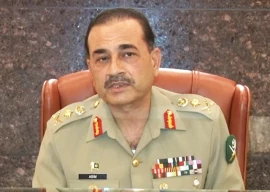
With President Barack Obama winning a second term, the US exit policy conceived by his administration will be implemented and American troops are likely to be pulled out as per stated policy, maybe even earlier than 2014. The proposed exit policy will have a great impact on the future security environment in the region. Different scenarios may emerge before the withdrawal of US forces from Afghanistan.
One scenario could be that a breakthrough is achieved in the peace process with the Taliban and other insurgent groups decide to join a broad-based interim government in Afghanistan. The modalities for future elections, amendment to the Constitution and details about post-exit assistance to be provided by the US are worked out and agreed upon by all. Elections are held under the supervision of Isaf and an elected government takes charge before the withdrawal of Nato forces. Before its exit, the US manages the resolution of the Durand Line issue through dialogue with all Afghan factions. These are the ideal and most desirable conditions for a smooth exit and transition. With peace between Afghanistan and Pakistan, the existing sanctuaries of the Tehreek-e-Taliban Pakistan (TTP) across the border will be denied to them, which in turn will weaken the TTP and their ability to conduct terrorist activities will be further diluted. If al Qaeda is not defeated by then, drone attacks will continue in Fata.
In the second scenario, a partial success is achieved in the peace process. There is a split in the ranks of the Taliban, some prominent leaders show their willingness to end the war and support peaceful means for transition. The momentum of the Taliban insurgency will be retarded to a great extent; however, they will continue with their activities to destabilise the government in Kabul. The Taliban may not be able to capture major cities but are likely to establish their hold in some eastern provinces, depending on the Haqqanis’ role in the peace process. In this situation, Nato forces will exit but the US may have to leave some forces, intelligence set-up, fighter aircraft and drones in Afghanistan to deal with insurgents. The TTP will continue with their activities by establishing sanctuaries in Afghan areas that are not in Kabul’s control.
The most dangerous scenario would be the inability of the Nato forces to retard the momentum of the insurgency by 2014, failure to achieve any breakthrough in the peace process with the exit strategy remaining unrevised and forces withdrawing. A general perception is likely to emerge that another superpower has been defeated through jihad. This will give a new lease of life to al Qaeda and jihadists all over the world. There will be more violence against US facilities in the world. In case a division emerges in the Afghan National Security Forces, there may be a civil war with different factions fighting for control of Kabul. The TTP will gain strength, regroup and make all possible efforts to regain grounds they lost to the Pakistan Army. Dealing with them will be an uphill task for the army. The region may witness instability never seen in the past.
One issue, if resolved, could lead to lasting stability in the region; i.e., recognition of the Durand Line as an international border by Afghanistan. At present, even the discussion of this issue is considered taboo by Afghans. The Durand Line Treaty was signed in 1893 by Afghanistan with Britain and was validated by different Afghan rulers in 1905, 1919, 1921 and 1930. The Durand Line is the only Afghan border determined bilaterally between Afghanistan and Britain; all northern borders were determined by Russia and Britain without Afghanistan’s participation. As per the Vienna Convention on Succession of States in Respect of Treaties, bilateral agreements are “passed down” to successor states. The Durand Line is associated with the interrelated issue of Pashtunistan. Pashtuns are now so well integrated in Pakistani society that there is hardly any supporter of Pashtunistan in this country. In case the US and other world powers succeed in persuading Afghans to recognise the Durand Line, it will open a new chapter in relations between Afghanistan and Pakistan ending interference in each other’s internal affairs, prove more beneficial for Afghans and also help the US in its war on terror and exit from Afghanistan.
Published in The Express Tribune, November 25th, 2012.
COMMENTS (28)
Comments are moderated and generally will be posted if they are on-topic and not abusive.
For more information, please see our Comments FAQ




















1713272658-0/Copenhagen-fire-(1)1713272658-0-270x192.webp)























If anything, the Durand line issue will be used by Americans to pressure/punish pak post-2014. The world is not about to forget the double games played by pak.
An advice to pak: being the bigger/stronger country of the two (Afghanistan/Pakistan), pak should make unilateral concessions on the Durand line.
The author writes: "Pashtuns are now so well integrated in Pakistani society that there is hardly any supporter of Pashtunistan in this country."
I guess he means a handful of Pashtuns that benefit from the crumbs thrown at them by the establishment. Millions of Pashtuns in KPK, FATA and Balochistan languish in poverty disenfranchised and not integrated into mainstream Pakistani society.
They may not support the cause of Pashtunistan but they definitely want greater autonomy whether it is under the nationalist banner of Pashtunistan or a Pan-Islamic Taliban state made up of Pashtuns. Either way they are tired of their puppet masters and are looking for a way out.
There is one important point missing in this article: economic development in Afghanistan. Unless the Afghans will be provided - mainly by Western donors - with job opportunities and chances to generate enough revenue for the government to deliver social and other services to the people the country will remain a hotbed of tribal and ethnic unrest, feuds, even civil war.
While discussing Durand Line issue, whether the Author have same views about MacMohan Line? If so whether he support India's sovereignty over Aksai Chin Area? The Durand Line was never a territorial boundary. It was not even a Line of Actual Control. Read history carefully, it was just an arrangement to avoid conflict between Afghan and British in tribal areas.
The Durand line is just one problem. The bigger problem is the perception-war for Pakistan.
Pakistan is already isolated in the world now and has harboured Terrorists of all kinds, even Osama. Whats stopping the free world from sanctioning Pakistan? Or, atleast stop all kinds of aid and loans from International financial institutions, like WB and IMF?
Does anyone in Pakistan really going to think that the world will forget the double game Pakistan has played with NATO? No likely..
Well said Jat
The Afghans regard this as a sensitive issue__the Durand Line.
But they have bigger problems to tackle .
Ever since the Durand Line was created the tribal folk on both sides have been in practice ignoring it . Is that a reality or NOT ?
@sabi;I have no doubt that you are not aware about the events,unfolded between 1949-1963.Attack on Chaman-1954,Bajaur-1961,Pashtunistan Assembly,Pashtunistan President,removal of Nawab Shahjehan,Jandul Khan,of Dir.What is a dead issue,please clarify?Apparently you have your own biases/preconceived ideas, based on stories you have heard,which may not be true.Afghan laid claims on areas, where i belong to,as late as 2001,once Taliban were ruling.Durand Line resolution is the solution for a lasting peace in the region.
@Brig Harwant Singh (Retd): Durand line is a card in the hand of establishment.It's a card and nothing more.There is a set purpose behind, to highlight this dead issue on different forums.And that is, keep strategic depth policy going.Establishment has plenty of cards in its pocket for use, to remain overall incharge of Pakistan.It's not going to learn any lesson by it's own.It is playing with fire.Pakistan ka Khuda Khafiz.
@Javed Mohmand: Durand line maybe the only problem between Pakistan and Afghanistan but US intrvention did not cause this problem which has existed since 1947. Thus it is a wish list to expect that US will resolve it.
The only thing that US would like to ensure is that Afghanistan does not become a safe haven for Al Qaeda as it once was. To that end, it would like to work towards a pluralistic elected government rather than Pakistani proxies in charge of Afghanistan when they leave.
It is interesting that the Brigadier saab did not provide any advice for Pakistan to deal with the various Af-Pak scenarios in wake of US withdrawal. He could have suggested that Pakistan use the interim period to shut down its own jihadi infrastructure while ISAF/NATO forces are still in Afghanistan. The task will become an order of magnitude more difficult once US leaves.
What would happen to the concept of 'Strategic Depth' post 2014 ?
It is unlikely that any Afghan govt would 'officially' recognise the Durand Line.
@Gul @Jat :Any one who is of the opinion that this is a "Wish list" should come out with other possible scenarios.Pakistan's only problem with Afghanistan is Durand Line.Since 1949 Afghans have been supporting Pashtunistan cause so this is one of the security concerns of Pakistan.I agree with the writer that resolution of Durand Line issue will be a step towards ensuring long lasting peace in the region. @Anonymous:Punjabi,Sindhis,Baloch are also divided,there are many other divided ethnic groups in the world,attributing division of Pashtuns as a cause of religious extremism is farfetched and has no relevance to ground realities.
My take of the scenario is by 2014 America leaves but keeps a small force in Kabul. This is the most advantageous position it can get. To conquer territory Taliban has to come out of its hiding places in Pakistan and to Afghanistan. The moment Mullah Omer sets his foot in Afghanistan he will be a sitting duck for the drones. Expect more drones, better drones to do the job.
If seen superficially, army's policy seems to be to sit and watch as the country burns, others may see a more sinister policy. Throughout the last decade with 30,000 civilians and 5000 military personnel dead, their attitude has not changed. Expect more chaos if the real rulers of the country keep dreaming of a Talibanied Afghanistan come 2014.
there would be no peace at all as factions will fight wit each other for the area..
Rubbish. The Durand Line isn't an issue with the various parties who are waging war in Afghanistan - but if America stops what they are doing and focuses on helping Pakistan with this issue things are going to be just peachy.
"Post-exit Af-Pak scenarios" +++++++++++++++++++++ May I congratulate the author to have written a piece with no mention of the Haqqani Gang and Mullah Omar. Well done !
"With President Barack Obama winning a second term, the US exit policy conceived by his administration will be implemented and American troops are likely to be pulled out as per stated policy, maybe even earlier than 2014." I'm surprised the ones who keep basing their op-eds on the concept of a full withdrawal in 2014 manage to still get space to write it in.
we'll take over afghanistan after 2014.....time to unpack our 2 million soldiers................:D
Taliban and peace are two opposit things.As long as soveregnity of God clause exist in our constitution,peace in the region will remain a distant dream.Talibans are strategic assets which will help implement Pakistan hegemony in Afghanistan and beyond.Because self appointed thekedar of Islam think themselves as vice of God on earth and they are doing it as their constitutionaly duty.Constitution of Pakistan and peace in the religion are inter related.Believe it or not time will tell.
Brigadier saab you say, "Before its exit, the US manages the resolution of the Durand Line issue through dialogue with all Afghan factions."
Why would the Americans be interested in getting involved in the Durand Line issue ? After all this issue can be sorted out between Pakistan government and their allies, the Taliban.
Let us try and lay down some credible scenarios, not just your wishlist.
@Asad - A good article. Most realistically, it will be something between the option 2 & 3 you have cited. Since you are an insider, it would have been good to see speculations inside the military establishment on what scenario is more likely and why. I agree that this about time we resolve the Durand line issue.